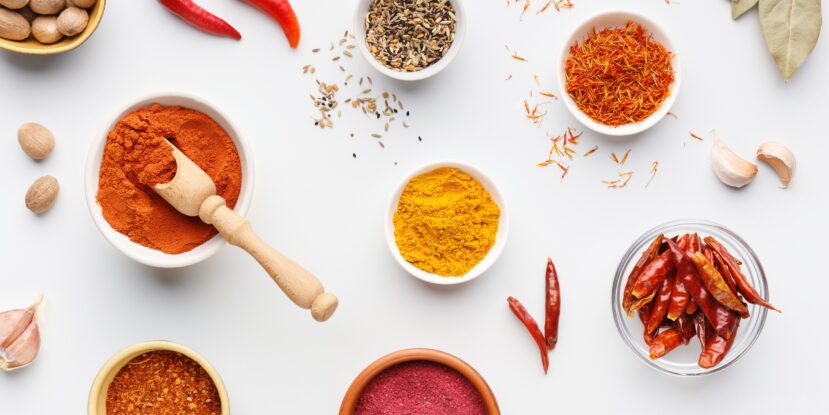Smak jest jednym z podstawowych zmysłów, który – podobnie jak pozostałe – może dostarczyć nam mnóstwo przyjemności. To dzięki niemu krok po kroku rozpoznajemy składniki tworzące daną potrawę, sprawiając tym samym niesamowitą gratkę naszym kubkom smakowym. Jednak czy zastanawialiście się kiedyś, jak właściwie działa ów smak? Jakie czynniki warunkują to, jak go odczuwamy? Przygotowałam artykuł pełen ciekawostek, które pozwolą Wam zgłębić ten temat. Zapraszam!
Zacznijmy od początku. Jak się okazuje, cztery podstawowe smaki, czyli słodki, słony, gorzki i kwaśny, zostały odkryte już 2400 lat temu (prawdopodobnie przez Demokryta)! Z kolei znany nam dzisiaj piąty smak – umami – to stosunkowo świeży „wynalazek”, którego dokonał dr Kikunae Ikeda w 1908 roku. W języku japońskim umami oznacza „esencję pyszności”, często opisywaną jako smak mięsisty, pikantny, pogłębiający smak.
Istnieje również zjawisko określane chemestezą – czyli wrażenie smakowe wywoływane przez różne związki chemiczne. Najczęściej spotykane to doznania wywołane zjedzeniem produktów o ostrym smaku, takich jak papryczki chilli, czy wrażenie chłodu po spożyciu mentolowych przekąsek, cukierków.
Jak rozpoznajemy smak?
Doznania smaku odpowiadają za ok. 20% doznań degustacyjnych, a prawie cała reszta, czyli aż 80%, to wrażenia zmysłu węchu. Zapach jest bodźcem zdecydowanie bardziej skomplikowanym. W 2004 roku naukowcy Richard Axel i Linda Buck otrzymali Nagrodę Nobla właśnie za badania nad układem węchowym i receptorami węchu – to dzięki nim wiemy, jak ważną funkcję ten zmysł pełni również w kontekście spożywanej żywności.
Węch odbierany jest za pomocą wyspecjalizowanych chemoreceptorów, reagujących na obecność tzw. odorantów (określonych składników chemicznych). O ile receptory smaku (np. odpowiadające za słodycz) są aktywowane przez różne związki (np. fruktozę czy sacharozę zawartą w żywności), o tyle różne związki wyzwalają jedynie określony receptor zapachu.
Smak jest również odbierany za pomocą receptorów znajdujących się na kubkach smakowych na naszym języku (w uproszczeniu: mowa tu o małych kropkach widocznych gołym okiem na powierzchni języka). To właśnie dzięki nim jesteśmy w stanie identyfikować różne smaki, wysyłając sygnały do naszego mózgu. Co ciekawe, receptory smaku słodkiego, gorzkiego czy umami są umieszczone również w innych miejscach, np. w jelitach! Ba, istnieją nawet zwierzęta, które odczuwają smak za pomocą innych części ciała – tu przykładem może być mucha używająca do tego swoich odnóży.
Jakie czynniki wpływają na nasz „odbiór″ smaku?
#1 Rodzime smaki
Jest mnóstwo czynników warunkujących sposób, w jaki odczuwamy dany smak. Może to być chociażby… wychowanie w konkretnym środowisku kulturowym.
Ten, kto podróżował do krajów azjatyckich, z pewnością zauważył, że w tamtejszej kuchni przeważa smak umami, nieobecny w takim stopniu w europejskiej kulturze kulinarnej. Różnice pojawiają się także w poziomie ostrości — wie ten, kto miał okazję jeść np. oryginalne potrawy tajskie przygotowane przez rodzimych Tajów!
#2 Smak wyssany z mlekiem matki?!
Okazuje się, że sposób, w jaki odczuwamy smaki, rozwija się w nas jeszcze przed narodzinami. Często to, czym „karmiły” nas mamy jeszcze w życiu płodowym, wpływa na nasze preferencje smakowe w przyszłości.
Wrażliwość na smak zmienia się również z wiekiem. Dzieci uwielbiają słodkości, ponieważ młody organizm zorientowany jest na przyjmowanie posiłków o dużej wartości energetycznej. Z kolei osoby starsze mają tendencję do przesalania swoich posiłków – dzieje się tak dlatego, że ich receptory smakowe działają słabiej i odczuwają smak w inny sposób.
Istnieje także zjawisko tzw. ageusji, czyli ślepoty smaku, polegającej na niezdolności do odczuwania i charakteryzowania doznań, jakie płyną z posiłku. Często niestety jest to związane z określoną chorobą, która może stanowić kolejny czynnik wpływający na wrażenia smakowe.
#3 Smak poprzedniego posiłku
Czy wiecie, dlaczego w restauracjach często na początku uczty kelner przynosi nam koszyczek z chlebem? To wcale nie po to, żebyśmy się nim najedli — jego główny cel to oczyszczenie kubków smakowych z pozostałości tego, co jedliśmy poprzednio.
Specjaliści udowodnili, że to, co jemy, może wpływać na percepcję smaku kolejnej potrawy.
Inną metodą oczyszczania kubków smakowych jest m.in. wypicie gazowanej wody mineralnej przed posiłkiem czy spożycie kilku krakersów.
#4 Suche powietrze i temperatura a smak
To, w jaki sposób odczuwasz smak, zmienia się również ze względu na czynniki środowiskowe. Wśród nich wymienić możemy m.in. wilgotność powietrza. Gdy jest ono zbyt suche, zmniejsza się ilość wydzielanej śliny, a w konsekwencji – także nasza wrażliwość na smak. Suche powietrze często występuje we wnętrzu samolotu, dlatego na pokładzie często serwuje się słone orzeszki czy precelki, które charakteryzuje wyrazisty smak.
Kolejnym czynnikiem wpływającym na odbiór smaku jest temperatura. Ciepłe potrawy (powyżej 30 st. C) wydają nam się bardziej aromatyczne i smakowite niż te o niższej temperaturze. Zapewne mieliście okazję pić kiedyś ciepły napój gazowany pewnej znanej marki… Czy także uważacie, że nieschłodzony jest mocno za słodki? No właśnie!
#5 Superdegustatorzy są wśród nas!
Wśród nas istnieje grupa ludzi, tzw. superdegustatorów, którzy są wyjątkowo wrażliwi na smak. Decydują o tym czynniki genetyczne, więc jeśli smak jarmużu, kapusty, brokuła czy brukselki wydaje Wam się wyjątkowo gorzki, możliwe, że należycie do prawdziwych smakoszy. 😉 Podobnie jest w przypadku kawy – superdegustatorzy odczuwają jej smak jako wyjątkowo goryczkowy. Prawdopodobnie właśnie dlatego częściej dodają do niej mleko lub śmietankę.
Badaniem nad smakiem i węchem zajmowała się amerykańska psycholog Linda Bartoshuk, która wykazała, że takie osoby rzadziej cierpią na otyłość. Superdegustatorów jest też więcej wśród mieszkańców Azji, Afryki czy Ameryki Południowej niż u rasy białej.
Podsumowanie
To tylko kilka z ciekawych aspektów, które wpływają na odczuwanie smaku. Mimo że wszyscy posiadamy kubki smakowe, każdy z nas odczuwa dany smak inaczej. Dzięki temu ciągle możemy odkrywać nowe smaki, a bogactwo kulinarne bezsprzecznie się powiększa!
Mam nadzieję, że dzięki temu artykułowi, udając się następnym razem do restauracji czy wsiadając na pokład samolotu, pomyślisz także o receptorach smakowych. 😉










 Młodszy specjalista ds. komunikacji marketingowej i PR.
Młodszy specjalista ds. komunikacji marketingowej i PR.


 Absolwent Uniwersytetu Warszawskiego oraz Szkoły Głównej Gospodarstwa Wiejskiego. W branży HoReCa od ponad 10 lat. Przez lata związany z Grupą Trip, Sobienie Królewskie Golf and Country Club oraz restauracją Florentin w Warszawe.
Absolwent Uniwersytetu Warszawskiego oraz Szkoły Głównej Gospodarstwa Wiejskiego. W branży HoReCa od ponad 10 lat. Przez lata związany z Grupą Trip, Sobienie Królewskie Golf and Country Club oraz restauracją Florentin w Warszawe. Absolwentka Wydziału Architektury Politechniki Warszawskiej na kierunku Architecture for Society of Knowledge oraz Komunikacji Wizualnej na Politecnico di Milano. Specjalistka od budowania nastroju. Doświadczenie zdobywała w kraju i zagranicą podczas licznych warsztatów międzynarodowych (Sevilla, Lizbona, Florencja), stypendium na La Sapienza (Rzym) oraz pracując m.in. w Carmi e Ubertis i ADM Milano.
Absolwentka Wydziału Architektury Politechniki Warszawskiej na kierunku Architecture for Society of Knowledge oraz Komunikacji Wizualnej na Politecnico di Milano. Specjalistka od budowania nastroju. Doświadczenie zdobywała w kraju i zagranicą podczas licznych warsztatów międzynarodowych (Sevilla, Lizbona, Florencja), stypendium na La Sapienza (Rzym) oraz pracując m.in. w Carmi e Ubertis i ADM Milano.








 Menedżer z wieloletnim doświadczeniem w branżach kosmetycznej, spożywczej, dziecięcej. W trakcie swojej kariery związany z firmami takimi jak: L’Oreal, Samsung, Danone-Nutricia, Unilever. W ciągu swojego życia zawodowego odpowiadał między innymi za rozwój sprzedaży i contentu eCommerce w Polsce i krajach Europy Środkowo-Wschodniej.
Menedżer z wieloletnim doświadczeniem w branżach kosmetycznej, spożywczej, dziecięcej. W trakcie swojej kariery związany z firmami takimi jak: L’Oreal, Samsung, Danone-Nutricia, Unilever. W ciągu swojego życia zawodowego odpowiadał między innymi za rozwój sprzedaży i contentu eCommerce w Polsce i krajach Europy Środkowo-Wschodniej. 

























































